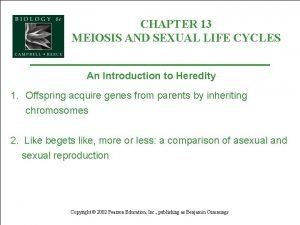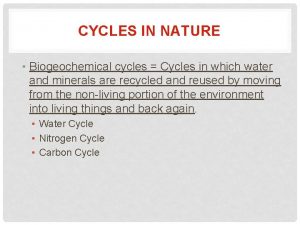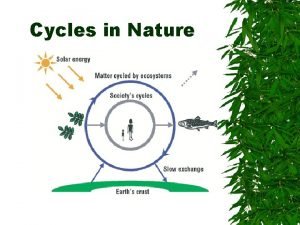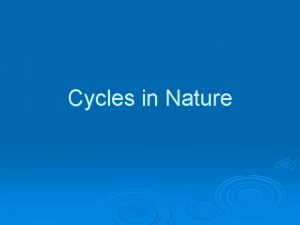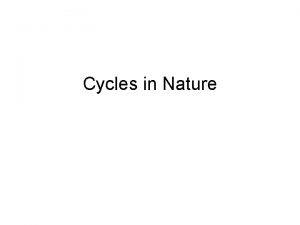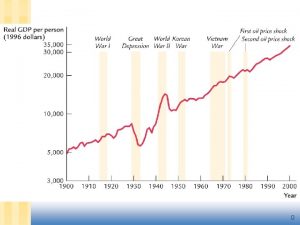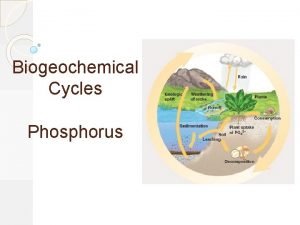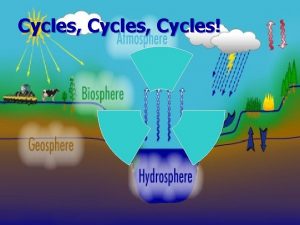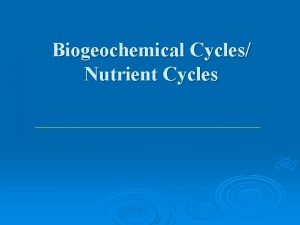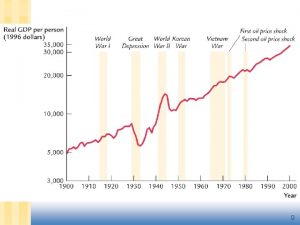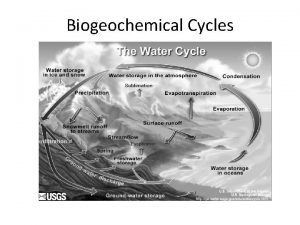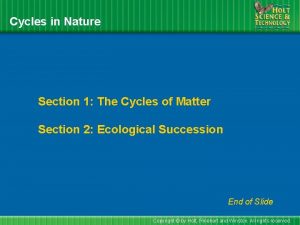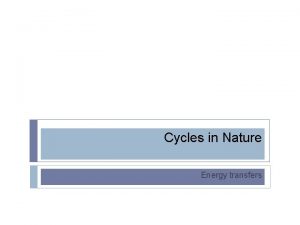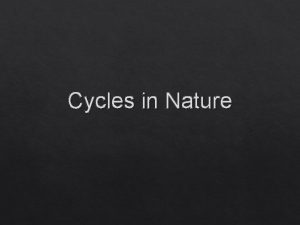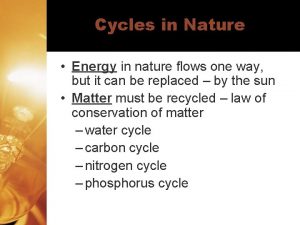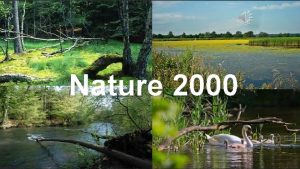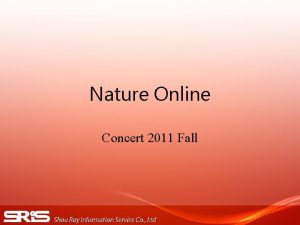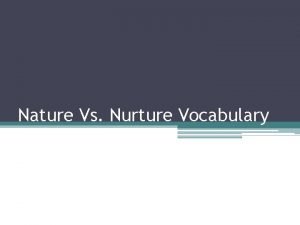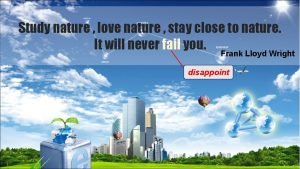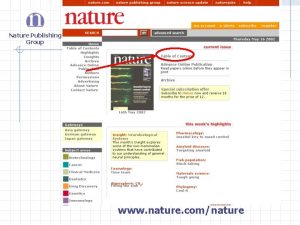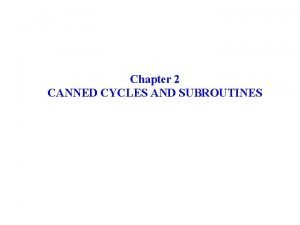Chapter 19 Cycles of Nature The Cycles of






































- Slides: 38

Chapter 19 Cycles of Nature

The Cycles of Matter The matter in your body has been on Earth since the planet was formed billions of years ago! Matter, which is anything that occupies space and has mass, is used over and over again. Each kind of matter has its own cycle. In these cycles, matter moves among the environment and living things.

The Water Cycle The movement of water among the oceans, atmosphere, land, and living things is known as the water cycle.

Precipitation Water moves from the atmosphere to the land oceans as precipitation, which includes rain, snow, sleet, and hail. About 91 percent of precipitation falls into the ocean. The rest falls on land, renewing the supply of fresh water.

Evaporation Water cycles back to the atmosphere through evaporation. During evaporation, the sun’s heat causes water to change from liquid to vapor. When the water vapor cools during the process of condensation, it forms a liquid that can fall to the Earth as precipitation.

Ground Water Some precipitation seeps into the ground, where it is stored in underground caverns or in porous rock. This water, known as ground water, may stay in the ground for hundreds or even thousands of years. Ground water provides water to the soil, streams, rivers, and oceans.

Water and Life All organisms, from tiny bacteria to animals and plants, contain a lot of water. Your body is composed of about 70 percent water. Water carries waste products away from body tissues. Water also helps regulate body temperature through perspiration and evaporation, returning water to the environment in a process called transpiration. Without water, there would be no life on Earth.




WEIRD SCIENCE Converting ice to liquid requires thermal energy. When the process is reversed, some thermal energy is given off. Farmers use this principle when they spray crops with water during sudden cold weather. As the water freezes on the fruit, heat is given off, which prevents the fruit from freezing.

SCIENCE HUMOR Q: If H 20 is water, what is H 20 4? A: Drinking

The Carbon Cycle Carbon is essential to living things because it is a part of all biological molecules. The movement of carbon from the environment into living things and back into the environment is known as the carbon cycle.


IS THAT A FACT ! A lush oasis can exist in a desert that seldom receives rain. Water beneath the desert, called fossil water, slowly seeps to the surface at the oasis, allowing plants and animals to live in an otherwise dry place. Fossil water is water that was trapped underground, away from the water cycle, tens of thousands of years ago. When the fossil water is gone, the oasis it feeds will disappear.

Photosynthesis is the process by which carbon cycles from the environment into living things. During photosynthesis, plants use carbon dioxide from the air to make sugars. Most animals get the carbon they need by eating plants.

Respiration How does carbon return to the environment? Animals and plants both respire. During, respiration, sugar molecules are broken down to release energy. Carbon dioxide and water are released as byproducts.

Decomposition The breakdown of dead materials into carbon dioxide and water is called decomposition. When fungi and bacteria decompose organic matter, they return carbon to the environment.

Combustion The carbon in coal, oil, and natural gas returns to the atmosphere as carbon dioxide when these fuels are burned. The process of burning fuel is known as combustion. Combustion provides much of the fuel people need to drive cars, heat homes, and make electricity.

The Nitrogen Cycle The movement of nitrogen from the environment to living things and back again is called the nitrogen cycle.

A Sea of Nitrogen About 78 percent of the Earth’s atmosphere is nitrogen gas. However, most organisms cannot use nitrogen gas to obtain the nitrogen they need to build proteins and DNA. But bacteria in the soil are able to change nitrogen gas into forms that can be used by plants. This is called nitrogen fixation. Most animals get the nitrogen they need by eating plants.

Back to Gas The final step of the nitrogen cycle is also performed by bacteria in the soil. These bacteria are different species than the bacteria that fix nitrogen. The bacteria break down dead organisms and animal wastes. This process produces nitrogen gas, which is returned to the atmosphere.


QUIZ 1. Compare the water cycle with the carbon cycle. What do both have in common? Answers will vary but should reflect an understanding that, in each cycle, matter is used over and over again.

QUIZ 2. Describe the role of living things in the carbon cycle. Answers will vary. Students should note that plants obtain carbon from the atmosphere, using it to make sugars during photosynthesis. When animals eat the plants, they take in the carbon. Both plants and animals release carbon dioxide during cellular respiration.

Ecological Succession Imagine you have a time machine that can take you back to the summer of 1988. If you had visited Yellowstone National Park during that year, you would have found large areas of the park burned to the ground. When the fires were put out, a layer of gray ash blanketed the forest floor. Most of the trees were dead, although many of them were still standing.

Regrowth of a Forest The following spring, the appearance of the “dead” forest began to change. Some of the dead trees are beginning to fall over, and small, green plants have begun to grow in a large numbers. National Park foresters report that the number and kinds of plants growing in the recovering area have increased each year since the fire.

Regrowth of a Forest (cont) A gradual development of a community over time, such as the regrowth of the burned areas of Yellowstone National Park, is called succession. Succession takes place in all communities, not just those affected by disturbances such as forest fires. Succession occurs through predictable stages over time.



Secondary Succession Sometimes an existing community is destroyed by a natural disaster, such as fire or flood. Or, a farmer might quit growing crops in an area that had been cleared. In either case, if soil is left intact, the original plant community may regrow through a series of stages called secondary succession.



Where Does It All End? In the early stages of succession only a few species grow in an area. These species grow fast and make many seeds that scatter easily. Because there are only a few species, they are open to invasion by other, longer-lasting species, disease, and other disturbances. In later stages, of succession there are usually many more species present.

Where Does It All End? (cont) Because of this, there are more pathways available to absorb disturbances. For example, in a mature forest, many species will survive an invasion by insects if these insects prefer to eat only one species of plant. Eventually, if an area experiences no fires or other disturbances, it will reach a more or less stable stage.

Where Does It All End? (cont) Communities change over time even though they are considered to be stable. A stable community may not always be a hardwood forest. Why might a stable hardwood forest not develop there? The answer is that the area does not have the kind of climate that will support a stable hardwood forest. The climate in this area supports a desert community.

QUIZ 1. Describe the main difference between primary and secondary succession. Primary succession takes place on newly exposed surfaces, where no living things have ever grown before. Secondary succession occurs when an existing community is destroyed and regrows through a series of stages.

QUIZ (cont) 2. Describe how pioneer species prepare an area for other living things. Chemicals released by the pioneer species break rock into smaller pieces, and their decaying matter enriches the soil.
 Cycles in nature
Cycles in nature Metaphase ii
Metaphase ii Chapter 13 meiosis and sexual life cycles
Chapter 13 meiosis and sexual life cycles Nature and nature's laws lay hid in night
Nature and nature's laws lay hid in night Nature nature controversy
Nature nature controversy Hình ảnh bộ gõ cơ thể búng tay
Hình ảnh bộ gõ cơ thể búng tay Lp html
Lp html Bổ thể
Bổ thể Tỉ lệ cơ thể trẻ em
Tỉ lệ cơ thể trẻ em Gấu đi như thế nào
Gấu đi như thế nào Tư thế worm breton
Tư thế worm breton Chúa sống lại
Chúa sống lại Các môn thể thao bắt đầu bằng tiếng chạy
Các môn thể thao bắt đầu bằng tiếng chạy Thế nào là hệ số cao nhất
Thế nào là hệ số cao nhất Các châu lục và đại dương trên thế giới
Các châu lục và đại dương trên thế giới Công thức tính thế năng
Công thức tính thế năng Trời xanh đây là của chúng ta thể thơ
Trời xanh đây là của chúng ta thể thơ Mật thư tọa độ 5x5
Mật thư tọa độ 5x5 101012 bằng
101012 bằng Phản ứng thế ankan
Phản ứng thế ankan Các châu lục và đại dương trên thế giới
Các châu lục và đại dương trên thế giới Thể thơ truyền thống
Thể thơ truyền thống Quá trình desamine hóa có thể tạo ra
Quá trình desamine hóa có thể tạo ra Một số thể thơ truyền thống
Một số thể thơ truyền thống Cái miệng nó xinh thế
Cái miệng nó xinh thế Vẽ hình chiếu vuông góc của vật thể sau
Vẽ hình chiếu vuông góc của vật thể sau Nguyên nhân của sự mỏi cơ sinh 8
Nguyên nhân của sự mỏi cơ sinh 8 đặc điểm cơ thể của người tối cổ
đặc điểm cơ thể của người tối cổ V cc
V cc Vẽ hình chiếu đứng bằng cạnh của vật thể
Vẽ hình chiếu đứng bằng cạnh của vật thể Fecboak
Fecboak Thẻ vin
Thẻ vin đại từ thay thế
đại từ thay thế điện thế nghỉ
điện thế nghỉ Tư thế ngồi viết
Tư thế ngồi viết Diễn thế sinh thái là
Diễn thế sinh thái là Dot
Dot Các số nguyên tố
Các số nguyên tố Tư thế ngồi viết
Tư thế ngồi viết


